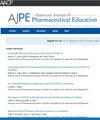对药学专业学生工作动机和工作时间后果的调查分析。
IF 3.8
4区 教育学
Q1 EDUCATION, SCIENTIFIC DISCIPLINES
引用次数: 0
摘要
目的确定药学学生在药学博士学期的每周工作时间、工作或不工作的主要原因以及工作时间对其药学教育经历的影响:在 2024 年 1 月至 2 月期间,对三所药学院药学博士课程的 P1 - P4 学生进行了一次多中心横断面调查。该匿名调查包含 22 个项目,询问了学生的特征、目前和理想的带薪工作时间、工作的主要原因以及工作时间对药学教育的影响:共有 622 名药学专业学生参与了此次调查(回复率为 61%)。社区药房(39%,人数=242)和医院住院药房(29%,人数=179)是参与者最常见的工作环境。据统计,学生每周报告的平均工作时间高于理想工作时间(12.3 小时对 10.8 小时)。大多数学生对自己每周的工作时间感到满意(63%,人数=307)。学业任务是学生工作时间少于理想时间的主要原因(76%,人数=65),而经济需要是学生工作时间多于理想时间的主要原因(86%,人数=82)。学习时间减少(90%,人数=84)、压力和疲劳增加(72%,人数=67)以及课外活动受限(59%,人数=55)是工作时间超过理想工作时间的后果:结论:大多数学生对自己平均每周 12 小时的工作时间感到满意。结论:大多数学生对自己平均每周 12 小时的工作时间感到满意。经济上的需要是学生工作时间超过理想工作时间的主要原因,而过长的工作时间可能会导致学生对药学教育的参与度降低。教师在与学生讨论如何平衡工作和学业时可以利用这些信息。本文章由计算机程序翻译,如有差异,请以英文原文为准。
A Survey Analysis of Motivations and Perceived Consequences of Work Hours Among Pharmacy Students
Objective
To determine pharmacy students’ weekly work hours during Doctor of Pharmacy (PharmD) semesters, the primary reasons for working or not working, and how work hours impact their pharmacy education experience.
Methods
A multicenter cross-sectional survey was conducted among first-year (P1) to fourth-year (P4) pharmacy students enrolled in PharmD programs at 3 colleges of pharmacy between January and February 2024. The 22-item anonymous survey queried student characteristics, current and ideal paid work hours, primary reasons for working, and perceived consequences of work hours on pharmacy education.
Results
A total of 622 pharmacy students participated in this survey (61% response rate). Community pharmacies (39%, n = 242) and inpatient hospital pharmacies (29%, n = 179) were the most common work settings for participants. Mean reported student work hours per week were statistically higher than ideal hours (12.3 vs 10.8). Most students were comfortable with their weekly work hours (63%, n = 307). Academic commitment was the main reason for students working fewer than ideal hours (76%, n = 65) while financial necessity was the primary reason for students working more than their ideal hours (86%, n = 82). Reduced study time (90%, n = 84), increased stress and fatigue (72%, n = 67), and limited extracurricular involvement (59%, n = 55) were consequences of working beyond ideal work hours.
Conclusion
Most students are comfortable with their average 12-h/week work hours. Financial necessity is a primary reason for students working more than their ideal hours, and excess work hours may contribute to reduced student engagement in pharmacy education. Faculty can use this information in their discussions with students balancing work and academic commitments.
求助全文
通过发布文献求助,成功后即可免费获取论文全文。
去求助
来源期刊
CiteScore
4.30
自引率
15.20%
发文量
114
期刊介绍:
The Journal accepts unsolicited manuscripts that have not been published and are not under consideration for publication elsewhere. The Journal only considers material related to pharmaceutical education for publication. Authors must prepare manuscripts to conform to the Journal style (Author Instructions). All manuscripts are subject to peer review and approval by the editor prior to acceptance for publication. Reviewers are assigned by the editor with the advice of the editorial board as needed. Manuscripts are submitted and processed online (Submit a Manuscript) using Editorial Manager, an online manuscript tracking system that facilitates communication between the editorial office, editor, associate editors, reviewers, and authors.
After a manuscript is accepted, it is scheduled for publication in an upcoming issue of the Journal. All manuscripts are formatted and copyedited, and returned to the author for review and approval of the changes. Approximately 2 weeks prior to publication, the author receives an electronic proof of the article for final review and approval. Authors are not assessed page charges for publication.

 求助内容:
求助内容: 应助结果提醒方式:
应助结果提醒方式:


